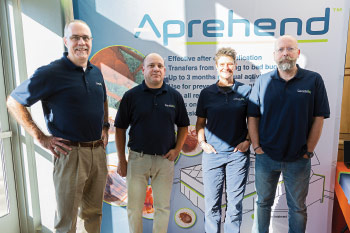Update: Biopesticide for Bed Bugs
 |
|
The ConidioTec team, from left: CEO Don McCandless, COO Giovani Bellicanta, CTO Nina Jenkins, and co-inventor and Professor of Entomology Matt Thomas. Photo by Jim Harding, Penn State College of Agricultural Sciences, CC BY-NC-ND 2.0. |
In April of 2014, we published a small notice on our website about a newly developed biopesticide that effectively kills bed bugs. The Northeastern IPM Center had funded a Regional IPM grant, Toward Implementation of a Novel Fungal Biopesticide for IPM of Bed Bugs, led by Nina Jenkins of Penn State. The fungal biopesticide spray is effective against immature and adult bed bugs that walk across as little as one inch of dry treated surface.
Fast forward four years, to June of 2018, and a lot has happened. The patent-pending product has received EPA registration. Jenkins and her team have formed a company, ConidioTec, to manufacture and market the product, now called Aprehend.
This success story has several interesting details: USDA-funded research, student training, product development, and private-sector investment.
Aprehend started as a dissertation chapter in entomologist Alexis Barbarin’s doctoral thesis and research. Jenkins and her crew did much hard work of product development, testing, registration, and company formation.
“This really has been quite a journey,” Jenkins said in a Penn State News article by Lisa Duchene. “I have learned so much over the past five years and have benefited from the help of so many people.”
Aprehend is now being used by professional pest management companies.
Bed Bug Central tested the product in one house and got positive results. In addition, the product has been tested on mice for potential allergenic reactions.
So, it looks like a promising up-and-coming technology, and something to watch.
Aprehend Product Website:
http://www.aprehend.com
Aprehend Field Trial:
http://senscionline.com/aprehend-field-study/
The Northeastern IPM Center promotes integrated pest management for reducing risks to human health and the environment. If republishing our news, please acknowledge the source (“From Northeast IPM Insights”) along with a link to our website.
